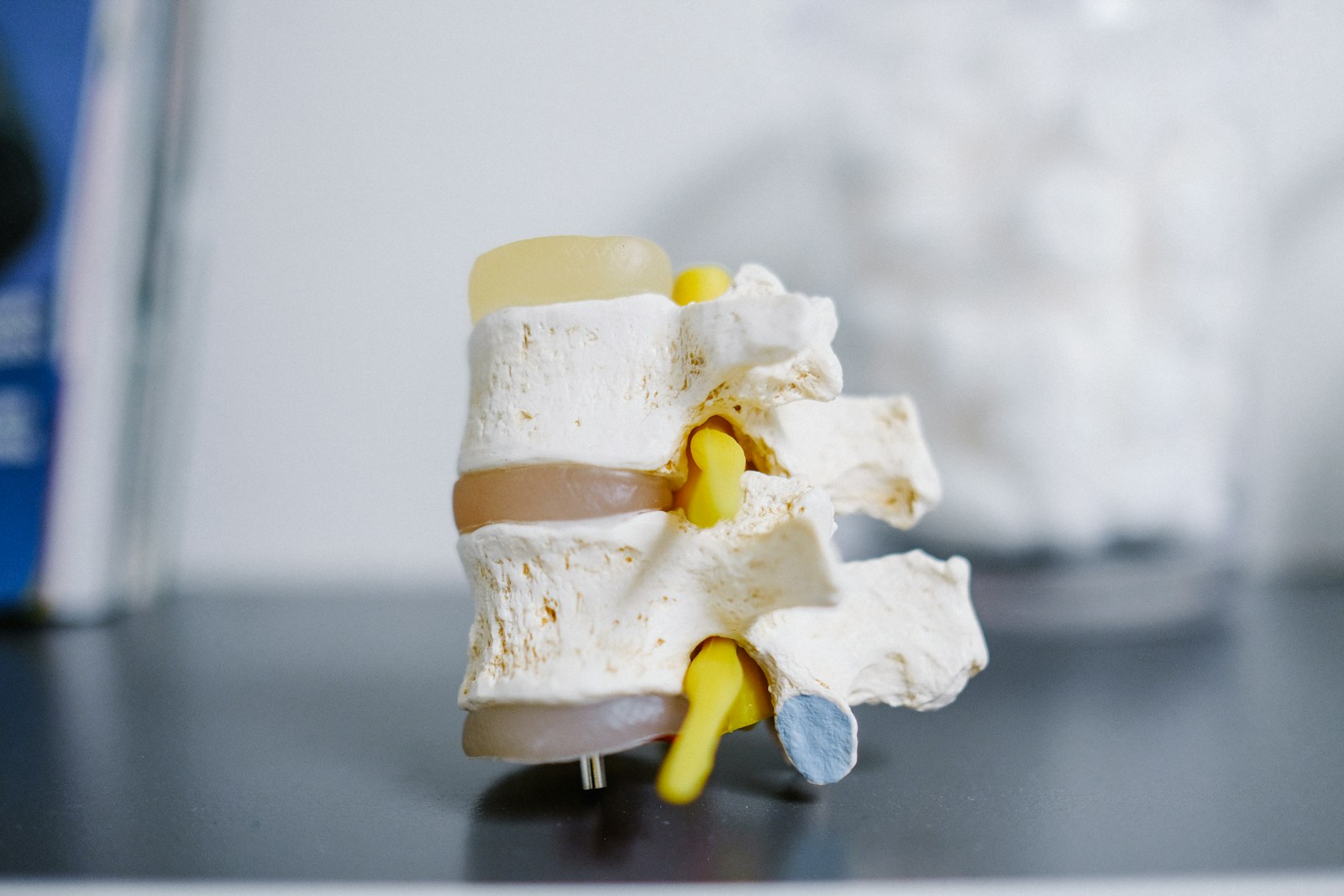The intricacies of the human body never cease to fascinate, especially when it comes to conditions like herniated discs that impact a significant proportion of the population worldwide. This intricate condition, which involves an aberration in one of the rubbery cushions (discs) between the individual vertebrae that stack up to form your spine, could be influenced by a myriad of factors. A thorough understanding of these factors and viable preventative measures can be instrumental in mitigating the risk and managing this condition, a topic we will explore further.
Understanding Herniated Disc
A substantial number of individuals worldwide grapple with the complex medical condition known as a herniated disc, an issue that arises when the soft, gel-like cushion between the vertebrae in the spine ruptures or shifts out of place. This displacement can compress surrounding nerves, causing severe pain, numbness, and weakness in the affected area.
The health and overall functionality of these discs are greatly influenced by two key factors: disc nutrition and disc hydration. Proper disc nutrition involves the intake of a balanced diet rich in essential vitamins and minerals that contribute to the maintenance and repair of the disc tissues. On the other hand, disc hydration pertains to the disc’s ability to retain adequate fluid levels, which helps maintain its flexibility and resilience.
Studies have shown that poor nutrition and dehydration can lead to disc degeneration, increasing the risk of a herniated disc. Maintaining good disc nutrition and hydration levels is vital in preventing disc herniation. Understanding these aspects can provide a basis for the development of preventive strategies and treatments for this debilitating condition.
Anatomy of the Spine
To better comprehend the causes and prevention of a herniated disc, understanding the anatomy of the spine is pivotal. The spine has numerous structural components, each with specific functions, including the pivotal role played by spinal discs. We will also discuss common spinal disorders to provide a thorough view of potential spinal health issues.
Spine’s Structural Components
Understanding the spine’s structural components necessitates a detailed examination of its complex anatomy, comprised of interlocking bones called vertebrae, which are cushioned by discs, and an intricate network of nerves, muscles, and ligaments.
- Vertebrae: These are individual bones stacked to form the vertebral column, providing structural stability and spine flexibility.
- Discs: Sandwiched between each pair of vertebrae, they act as shock absorbers, preventing the bones from grinding against each other.
- Nerves, Muscles, and Ligaments: These components are vital for movement and sensation. Spinal infections in these areas can lead to severe complications, including herniated discs.
Understanding these components can help in the prevention and treatment of herniated discs, by maintaining the health of the spine.
Functions of Spinal Discs
Serving as important shock absorbers in the spinal structure, spinal discs perform the essential function of preventing the vertebrae from rubbing against each other, thereby ensuring smooth and painless movement. The discs contribute to spinal flexibility by acting as pivotal points for the vertebrae. They are composed of a gel-like substance, which is crucial for disc nutrition as it retains water and nutrients crucial for disc health. The outer tough layer, annulus fibrosus, and inner soft core, nucleus pulposus, work together to distribute pressure evenly across the disc, mitigating the impact from daily activities. Consequently, the discs play a crucial role in maintaining the overall health of the spine, contributing to its strength, flexibility, and function.
Common Spinal Disorders
While the spinal discs play a significant role in maintaining spinal health, their malfunction can lead to common spinal disorders that affect the overall structure and function of the spine.
- Spinal Arthritis: This degenerative condition is often a result of wear and tear, and aging. It causes inflammation of the spinal joints leading to stiffness and pain.
- Herniated Disc: This occurs when the soft center of a spinal disc pushes through a crack in the tougher exterior casing causing nerve irritation, pain, and sometimes numbness or weakness.
- Scoliosis: An overview of this condition reveals a sideways curvature of the spine that usually occurs during the growth spurt just before puberty. The cause is primarily unknown and can lead to long-term health complications if severe.
Herniated Disc: A Closer Look
A herniated disc, often referred to as a slipped or ruptured disc, represents a prevalent issue in the spinal health domain, warranting a more detailed exploration. Delving into disc terminology, the spinal disc, an essential component of our backbone, is a gel-like substance enclosed by a tough outer layer. When a crack in this exterior allows the inner core to protrude, a herniated disc occurs.
Understanding the causes of a herniated disc is key. Commonly, it results from age-related wear and tear, also known as disc degeneration. With age, the spinal discs lose their flexibility, elasticity, and shock-absorbing characteristics, leading to potential herniation.
In severe cases, surgical procedures may be necessary, such as a discectomy, where the herniated disc is removed, or a spinal fusion, which joins two vertebrae together after the disc removal. However, these procedures are usually a last resort after non-surgical treatments have failed to relieve symptoms.
Common Symptoms of Herniated Disc
The manifestations of a herniated disc can vary widely in both nature and intensity, hence understanding common symptoms is important for accurate diagnosis and effective treatment. This section will discuss the typical indicators associated with a herniated disc, focusing on prevalent pain patterns and the range of severity encountered. In doing so, we aim to provide a thorough understanding of the physical signs that might suggest the presence of this condition.
Identifying Herniated Disc Indicators
Recognizing the symptoms of a herniated disc is important for timely diagnosis and effective treatment. These symptoms are closely linked to disc nutrition and can have a significant mental impact on the patient.
- Pain and Numbness: Often, the first indicator is pain, numbness, or a tingling sensation in the area where the affected nerve travels. This discomfort can range from mild to severe.
- Muscle Weakness: Muscles served by the affected nerves tend to weaken, which can cause stumbling or impair your ability to lift or hold items.
- Loss of Bowel or Bladder Control: This is a rare but serious symptom that requires immediate medical attention.
Understanding these key indicators can lead to early detection and management of a herniated disc, mitigating the mental stress associated with this condition.
Pain Patterns and Severity
Highlighting the aforementioned indicators, it is important to emphasize that the nature and intensity of pain in a herniated disc can vary greatly, often following specific patterns related to the location of the herniation. For instance, a herniated disc in the neck may cause Disc Related Headaches, characterized by persistent, throbbing pain at the back of the skull, extending to the forehead.
Additionally, the Emotional Stress Impact on patients cannot be overlooked as chronic pain can lead to anxiety and depression, worsening the overall condition. The severity of symptoms can range from mild discomfort to debilitating pain, depending on the extent of the nerve compression. Understanding these pain patterns is essential in the timely diagnosis and effective treatment of herniated discs.
Causes of Herniated Discs
In order to understand the development of herniated discs, one must first examine its various causes, ranging from physical strain to age-related degeneration. This condition stems primarily from three key factors:
- Disc Nutrition: The health of our spinal discs is largely dependent on adequate nutrition. Poor diet can lead to depletion of essential nutrients required for disc health, such as collagen, proteins, and water. This nutritional deficiency weakens the disc, increasing susceptibility to herniation.
- Disc Hydration: The discs in our spine require sufficient hydration to maintain their flexibility and strength. Dehydrated discs can become brittle and prone to damage. Over time, the loss of water content can lead to disc degeneration, a significant risk factor for herniation.
- Physical Strain: Excessive physical strain, often due to heavy lifting or repetitive movements, can put undue pressure on the spine, resulting in disc herniation. This is particularly true if the strain is coupled with poor body mechanics or posture.
Understanding these causal factors is important to developing effective preventive measures and treatment plans for herniated discs. Future discussions will focus on mitigating these risks to promote excellent spinal health.
Risk Factors for Herniated Discs
Understanding the risk factors for herniated discs is essential for both preventative measures and effective treatment. Factors such as age-related disc degeneration, the impact of physical activity, and genetic predisposition factors play significant roles in the likelihood of developing this condition. In the following section, we will explore these factors in detail to provide a thorough understanding of their implications.
Age-Related Disc Degeneration
As individuals age, a natural and unavoidable process known as disc degeneration often occurs, greatly enhancing the risk of developing a herniated disc. This degenerative process is influenced by various factors, including dietary habits and lifestyle choices.
- Dietary Influence: Poor nutrition can accelerate disc degeneration. A diet lacking in essential nutrients like calcium and vitamin D can weaken the spine, heightening the risk of herniation.
- Lifestyle Modifications: Sedentary behavior and obesity contribute to disc degeneration. Regular exercise and maintaining a healthy weight can provide significant benefits.
- Smoking: It has been established that smoking can exacerbate age-related disc degeneration due to decreased blood supply to the discs.
Understanding and addressing these factors can help mitigate the risk of developing a herniated disc in one’s advanced years.
Impact of Physical Activity
Physical activity, particularly the type and intensity, plays a pivotal role in the development of herniated discs. High-intensity exercises or activities that put a lot of strain on the back can increase the risk of disc herniation. This is especially true for improper lifting techniques or repetitive strenuous activities. However, it’s important to highlight that lack of physical activity can also boost the risk, as it leads to muscle weakness and poor posture, both contributing factors. Activity modification is hence essential in mitigating this risk. Regular, balanced exercise with a focus on core strength and flexibility is recommended. In cases of injury, a well-planned recovery program can prevent herniation or re-herniation, emphasizing the importance of professional guidance during injury recovery.
Genetic Predisposition Factors
While physical activity can influence the likelihood of a herniated disc, genetic factors also come into play, heralding a predisposition to this condition in certain individuals.
- Inherited disc disorders: Certain genetic mutations can result in conditions that weaken the spinal discs, making them more susceptible to herniation. These inherited disorders can be identified through genetic testing.
- Genetic testing benefits: Genetic testing can help in early detection of these predispositions, allowing for preventive measures to be taken. It also aids in understanding the severity and progression of the condition.
- Family history: A family history of herniated discs can indicate a genetic predisposition. If a close relative has had this condition, the chances of developing it increase.
Understanding these genetic factors can aid in prevention and management of herniated discs.
Diagnosing a Herniated Disc
In order to accurately diagnose a herniated disc, healthcare professionals perform a detailed examination that may include a physical evaluation, neurologic exam, and imaging tests such as MRI or CT scan. This thorough approach guarantees the precise identification of the condition, thereby facilitating the selection of appropriate non-surgical interventions.
Disc diagnosis methods typically commence with a thorough patient history to identify any activities or incidents that might have led to the herniation. The physical evaluation then involves evaluating the patient’s spine, posture, reflexes, muscle strength, and walking ability. A neurologic exam further evaluates nerve function and pinpoints any areas of numbness, tingling, or muscle weakness.
Imaging tests play a crucial role in the diagnosis of herniated discs. MRI scans are particularly useful, providing detailed images of the disc and helping to identify the exact location of the herniation. CT scans, on the other hand, offer cross-sectional views of the spine, further aiding in diagnosis.
In some cases, non-surgical interventions such as lifestyle modifications, physical therapy, and medication management are used initially, depending on the severity of the herniated disc. These interventions aim to reduce pain and improve the patient’s quality of life.
Treatment Options for Herniated Discs
When it comes to addressing herniated discs, an array of treatment options is available, ranging from conservative methods to surgical interventions, all tailored to the patient’s specific condition and lifestyle requirements. These approaches are designed to alleviate pain, restore function, and prevent further disc damage.
- Non-surgical remedies: This is often the first line of treatment and may include physical therapy, pain medications, and lifestyle changes. Physical therapy strengthens the muscles that support the spine, thereby reducing pressure on the disc. Over-the-counter pain relievers and prescription medications can help manage pain and inflammation.
- Epidural injections: If non-surgical remedies fail to provide relief, epidural steroid injections may be considered. This involves injecting a corticosteroid into the epidural space around the spinal cord to reduce inflammation and pain.
- Surgical interventions: Surgery is usually reserved for cases where non-surgical treatments have not been successful, or if the herniated disc is causing significant neurological symptoms. Common procedures include a microdiscectomy, where the portion of the disc pressing on the nerve is removed, or a spinal fusion, where two or more vertebrae are permanently connected to stabilize the spine.
Each treatment option has its own benefits and potential risks, which should be discussed in depth with a healthcare provider.
Health Habits to Prevent Herniated Discs
Adopting proactive health habits can be a formidable defense against the development of herniated discs, mitigating the risk factors associated with this debilitating condition. A key aspect of prevention is the understanding and incorporation of dietary impacts. A well-balanced diet, rich in anti-inflammatory foods, can contribute to maintaining a healthy weight, therefore reducing the pressure exerted on the spinal discs. Consuming adequate water may also help maintain the elasticity and height of intervertebral discs, reducing the propensity for rupture and herniation.
In the context of physical habits, posture correction plays a pivotal role in preventing herniated discs. Maintaining an upright posture, especially during activities that put significant strain on the back, such as lifting heavy objects, is important. Incorporating ergonomic aids in daily activities, such as supportive chairs and adjustable desks, can also facilitate better posture. Additionally, regular breaks from prolonged sitting or standing can help alleviate spinal pressure.
Exercises for Spine Health
Building upon the foundation of healthy habits and posture, it is equally important to contemplate the role of targeted exercises in maintaining and enhancing spine health. Regular physical activity not only reduces the risk of developing a herniated disc but also aids in managing existing conditions.
Implementing a regime of spine strengthening techniques and posture correction methods can be beneficial in fostering robust spine health. These include:
- Core strengthening: Exercises that focus on abdominal and back muscles help to stabilize the spine, reducing pressure on the discs.
- Flexibility exercises: Regular stretching helps maintain good posture and spinal alignment, reducing the risk of disc herniation.
- Aerobic exercise: Low-impact activities like swimming or cycling can enhance overall back health by improving circulation and reducing body weight.
Additionally, it is important to practice these exercises correctly to minimize the risk of injury. Consulting with a physical therapist or a trained professional can provide personalized guidance based on individual health and fitness levels. Remember, the goal is not just to heal, but also to fortify the spine against future ailments.
Living With a Herniated Disc
Although living with a herniated disc may pose various challenges, it is indeed possible to lead a fulfilling and active life by adopting suitable lifestyle adjustments, timely medical interventions, and proper pain management strategies.
The emotional impact of a herniated disc can be substantial, potentially leading to feelings of frustration, anger, and depression due to the chronic pain and limitations. Psychological counseling, stress management techniques, and support from loved ones can help mitigate these feelings and improve quality of life.
Dietary changes also play an important role in managing this condition. A balanced diet rich in anti-inflammatory foods like fruits, vegetables, lean proteins, and whole grains can aid in reducing inflammation around the disc, thereby relieving pain. Additionally, maintaining a healthy weight can alleviate pressure on the spine, reducing the risk of further disc damage.
Regular follow-ups with your healthcare provider are essential to monitor progress and adjust treatment plans as needed. With the right combination of medical care and lifestyle modifications, individuals living with a herniated disc can lead a productive life with minimized discomfort.
Frequently Asked Questions
What Is the Recovery Time After Surgery for a Herniated Disc?
Recovery time after herniated disc surgery varies, typically between 3-6 months. This includes post-surgical rehabilitation and potential occupational adjustments to prevent additional strain on the spinal column during the healing process.
How Does Age Affect the Likelihood of Getting a Herniated Disc?
Age profoundly influences the likelihood of a herniated disc due to Age Related Disc Changes. As we age, Disc Degeneration Impact increases, causing the discs to lose flexibility, elasticity, and shock absorbing capabilities.
Can a Herniated Disc Lead to Other Health Complications?
Yes, a herniated disc can lead to health complications such as disc-related sciatica, characterized by nerve pain, and increased spinal stenosis risks, which involves narrowing of the spinal canal causing nerve compression.
Is It Safe to Participate in Sports Activities With a Herniated Disc?
Participation in sports with a herniated disc depends on severity and symptoms. While certain disc-related exercises may be beneficial, it’s important to consult a health professional to make sure safety and consider non-surgical treatments if necessary.
Can a Herniated Disc Heal Itself Without Treatment?
There’s a common myth regarding disc herniation that it can heal itself naturally. While some symptoms may improve over time, professional medical treatment is typically necessary to fully treat and manage a herniated disc.



